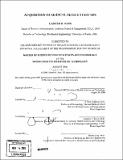| dc.contributor.advisor | R. Rox Anderson and Jonathan J. Rosen. | en_US |
| dc.contributor.author | Nair, Ganesh R | en_US |
| dc.contributor.other | Harvard University--MIT Division of Health Sciences and Technology. | en_US |
| dc.date.accessioned | 2008-11-10T19:48:45Z | |
| dc.date.available | 2008-11-10T19:48:45Z | |
| dc.date.copyright | 2006 | en_US |
| dc.date.issued | 2006 | en_US |
| dc.identifier.uri | http://dspace.mit.edu/handle/1721.1/37978 | en_US |
| dc.identifier.uri | http://hdl.handle.net/1721.1/37978 | |
| dc.description | Thesis (S.M.)--Harvard-MIT Division of Health Sciences and Technology, 2006. | en_US |
| dc.description | Includes bibliographical references (leaf [39]). | en_US |
| dc.description.abstract | Introduction: In the medical device space, a large proportion of the breakthrough inventions are developed by small firms that use private equity to bring their technologies from concept to varying stages of development. Medical Device companies spend a large proportion (11.4 % in 2002) of their sales on R&D, second only to Pharmaceutical companies. Smaller companies, in the meanwhile, spent 343 % of their sales in the same year'. [The Lewin Group (AdvaMed), 2004]. Private Equity financing is a critical factor that enables small start-ups to develop new technologies without a viable revenue stream to support the necessary R&D expenditure. In the medical device space, it has been noted that Venture Capital firms (VC's) use high risk capital to invest in early stage companies, and look for "exits" through either an Initial Public Offering (IPO) or through the sale of the start-up to an established firm. Corporations are also involved in varying degrees in early venture investments, through what is sometimes called Corporate Venture Capital (CVC), mainly for strategic reasons. Through CVC investments, some corporations hope, that as an insider, they would be able to judge better whether a particular company is a good target for acquisition. In this paper I review the exits through acquisition, from the perspective of venture backed start-ups, and hypothesize that factors related to the nature of investors, the type of investment, the impact of capital markets and the Intellectual Property of the company are associated with a higher exit valuation. | en_US |
| dc.description.statementofresponsibility | Ganesh R. Nair. | en_US |
| dc.format.extent | 38, [3] leaves | en_US |
| dc.language.iso | eng | en_US |
| dc.publisher | Massachusetts Institute of Technology | en_US |
| dc.rights | M.I.T. theses are protected by
copyright. They may be viewed from this source for any purpose, but
reproduction or distribution in any format is prohibited without written
permission. See provided URL for inquiries about permission. | en_US |
| dc.rights.uri | http://dspace.mit.edu/handle/1721.1/37978 | en_US |
| dc.rights.uri | http://dspace.mit.edu/handle/1721.1/7582 | en_US |
| dc.subject | Harvard University--MIT Division of Health Sciences and Technology. | en_US |
| dc.title | Acquisition of medical device start-ups | en_US |
| dc.type | Thesis | en_US |
| dc.description.degree | S.M. | en_US |
| dc.contributor.department | Harvard University--MIT Division of Health Sciences and Technology | |
| dc.identifier.oclc | 150474050 | en_US |
